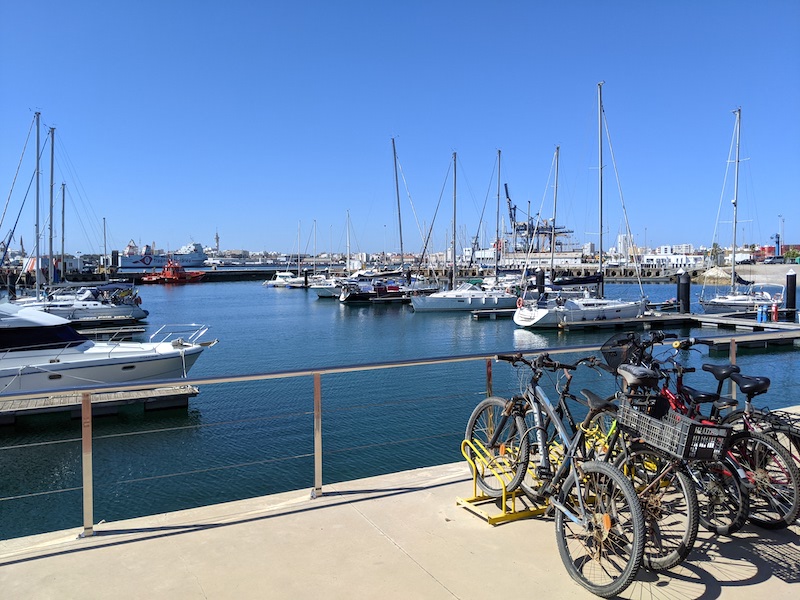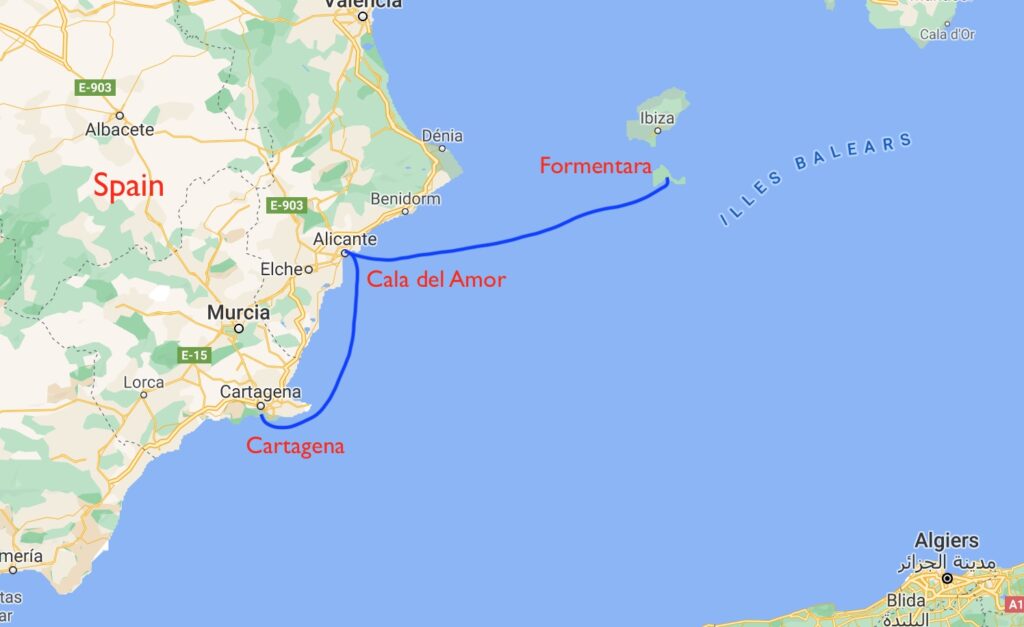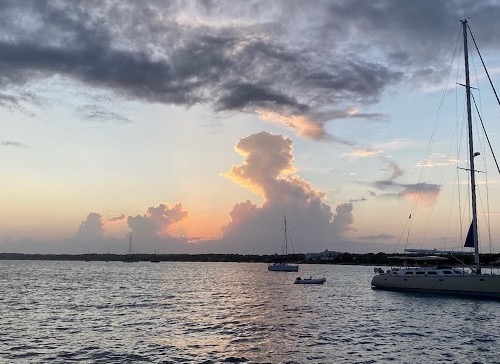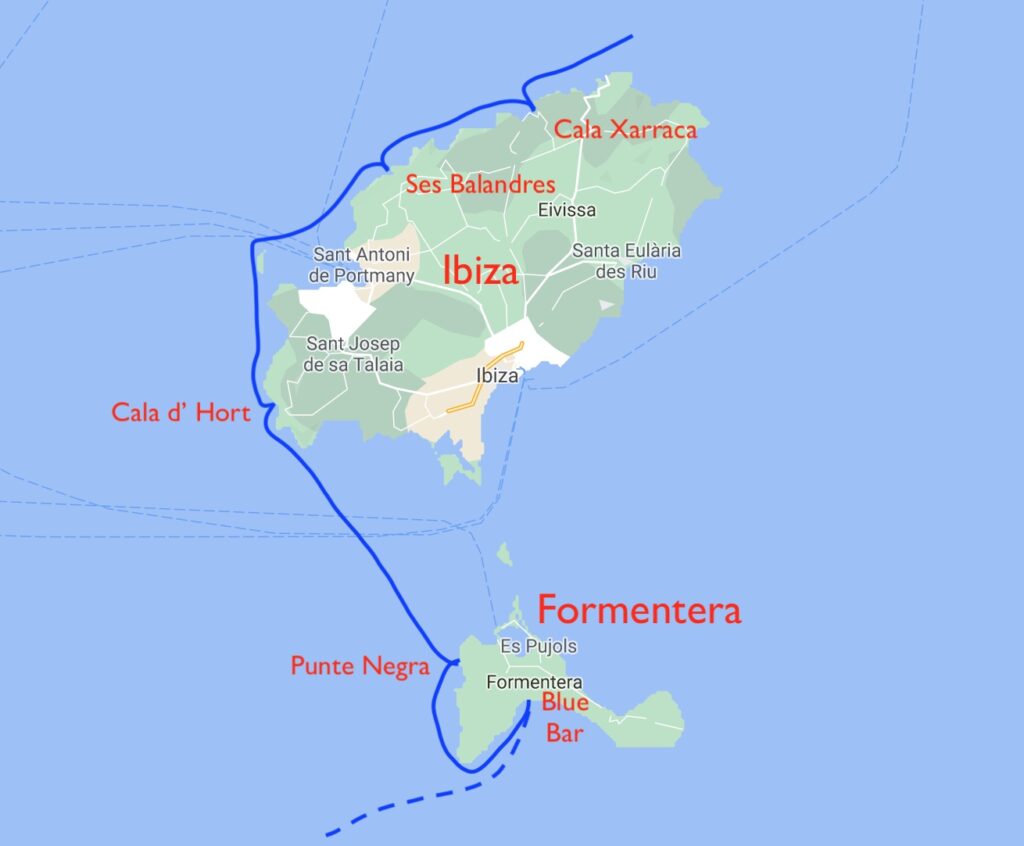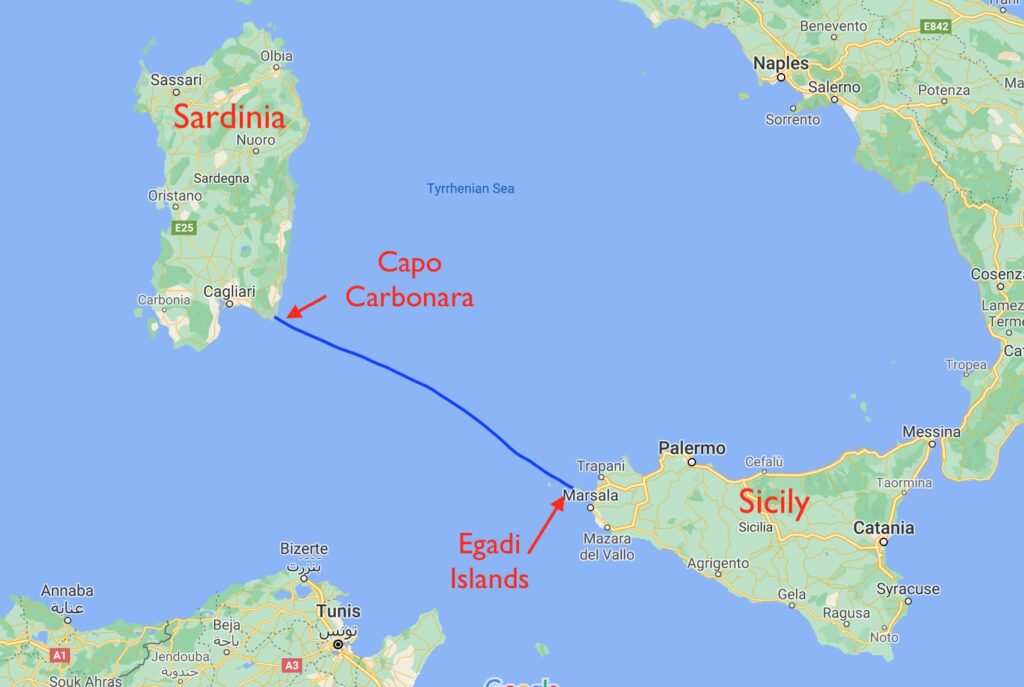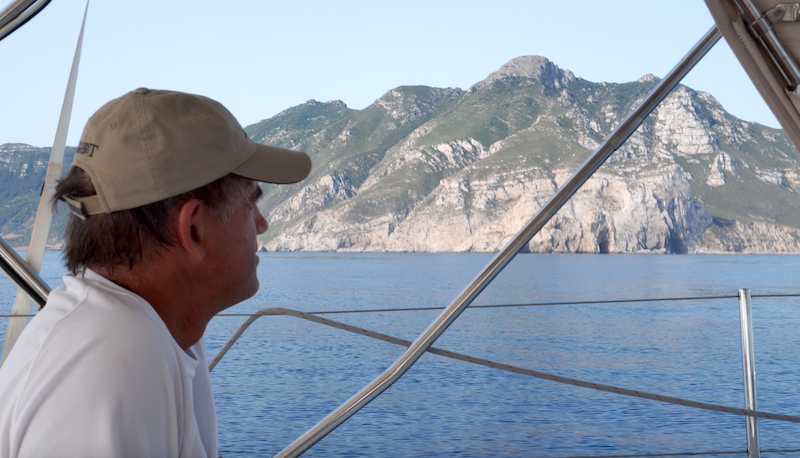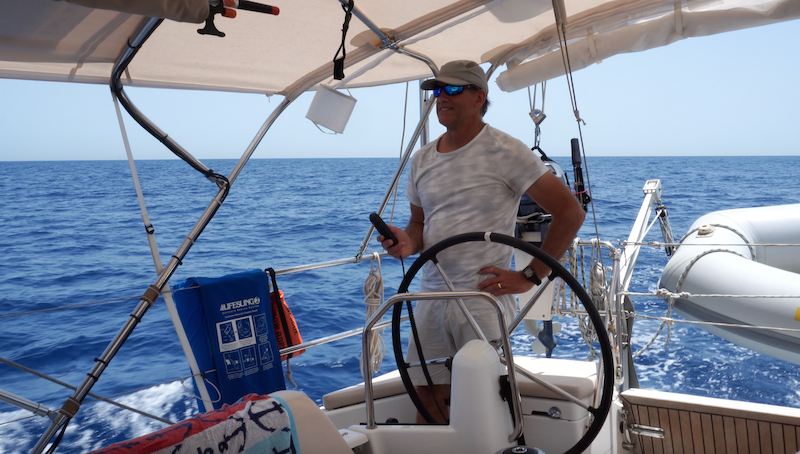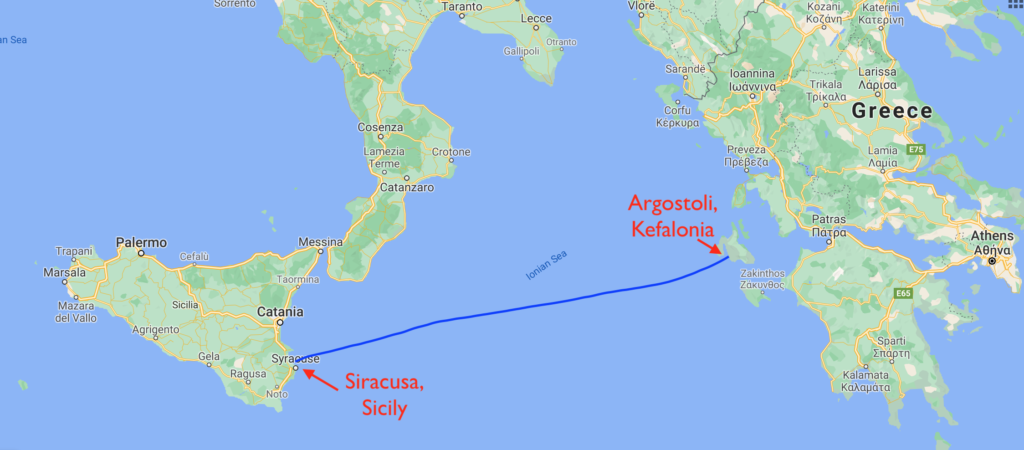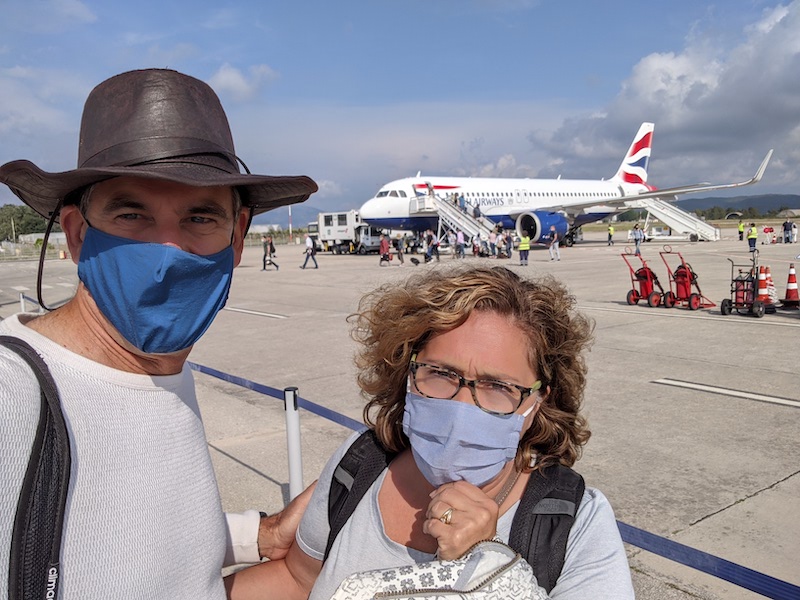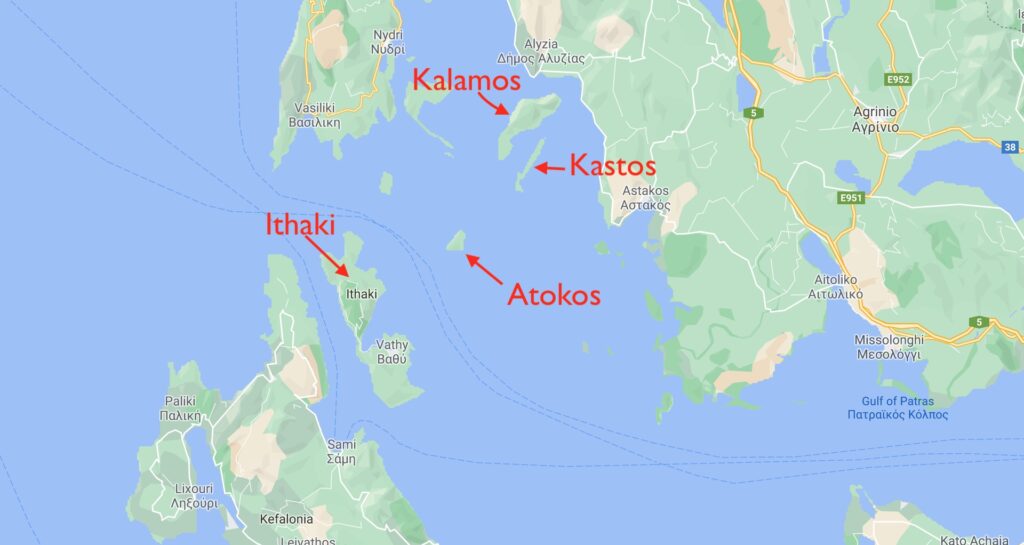On my first summer home from college, I found myself a bit behind on a search for a job. My high hopes to find a position in my field of engineering study had turned up empty. With just a year of advanced learning under my belt, it seemed like I was a charity case that no one wanted to take on. Before leaving for college, I had worked summers at a boat rental business in San Diego’s Mission Bay, far better than many of my other friend’s jobs working the fast food kitchen scene, but if I was going to have to revert to a mindless job, I wanted to try something different than the norm. I never liked to lean on friends, or more specifically, friend’s parents, but our family was connected to an executive at Sea World, and he was more than happy to line up a summer gig for me. When I showed up for work on the first day, I assumed I was going to be taking tickets or flipping over-priced theme park burgers. So you can imagine my surprise when I was told I would be a rotating crew member prancing around the park in a full-length costume of none other than Shamu, the iconic killer whale made lovable and non-threatening for all of the young children visiting the park. On one hour rotations, I would suit up, after spraying down the insides with deodorant, and walk around and pose for pictures with huge groups of little kids in tow. I’ll be the first to admit I’m not an extravert, but something fundamentally transformative happens when you dress up beyond recognition. You can be anyone you want and no one is the wiser. It was my summer acting sabbatical, and by far the funnest summer job I’ve ever had. After posing with me, little kids would tug the shirt tails of their parents for a stuffed Shamu toy or themed snow globe at the conveniently located adjacent store. And so it was good for business, before up-selling was really a thing. I’d hang up the costume at the end of the day, ride my bike an hour home, rest up and do it all again the next day. The not-so-subtle messaging for parents and kids was the undeniable charm, and dare I say cuddliness, of Shamu the Killer Whale. He might have a scary name, but if you could pose with him, buy him in a stuffed package, and watch a full-sized one leap out of the show tank and allow a trainer to stick his whole head in the giant mammal’s mouth, he’s not really that dangerous, right? Wrong!!
Killer whales, or orcas, as they are more appropriately named, have been known to injure or kill their trainers, a fact that Sea World was trying hard to play down. But yet, on the whole, they have largely been benign to humans, as people watch them safely from whale watching boats in popular sites like off Orcas Island in the Pacific Northwest. However, starting last summer, orcas started to attack boats off the Portuguese and Spanish Atlantic coasts, causing damage to sailboats in particular, and leading many boats to be towed to port for haul out and repairs. Orcas had visited boats in this region before, and in fact, they would commonly follow fishing boats that were netting their popular prey in these waters, the tasty tuna. But it was very rare for them to attack a boat. Yet, there were now regular reports of these ‘encounters’, as the scientists studying the matter would refer to the activity. Oddly, they had an affinity for sailboats; and, after swimming along next to the hull, they would turn more aggressive and push against the rudder, turning boats suddenly ninety degrees and causing injury to some skippers as the helm turned violently. They would often follow this up by biting at the rudder itself; and reports were coming in late last summer with pictures of boats hauled out and showing severely damaged rudders.
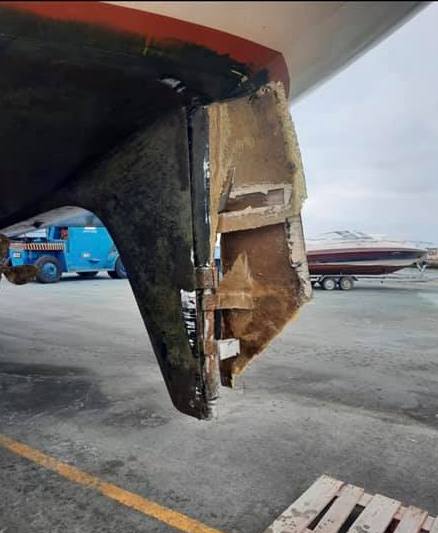
Our plans to leave the Med last summer had changed due to Covid, and while we stayed in Greece, we were still alarmed at the damage these orcas were doing. At one point last year the Spanish coast guard imposed a navigational restriction along the entire northwest coast of Spain for boats under 15 meters, which would have included our 12,6m Sea Rose. Reports were being gathered by a coalition of scientists called the Atlantic Orca Working Group, which showed ‘encounters’ from the northwest of Spain all the way down to Gibraltar. We hoped it was an anomaly last summer, but as sailboats started transiting the coast again this spring, reports started coming in again, with the most prevalent area for attacks being the stretch from Gibraltar to Cadiz, Spain.
As Karen and I made our way westward from Greece, we read with angst the accounts of other sailboaters that had been attacked. There were times when multiple attacks occurred in one week. It was easily the biggest source of stress we had, even more than the long multiple day passages we were enduring between islands. As we pushed west along Spain’s Costa del Sol, the stress level continued to increase, like a kettle ready to boil over. How were we going to get through this gauntlet? During an attack, the risk of injury was high, and if we had to be towed to an unknown port for repairs, that could put a halt to the rest of our season, and disrupt the plans of friends coming to sail with us.
Just two weeks before our planned passage between Gibraltar and Cadiz, sailboats were being struck almost every day. And no one, scientist or layperson, had any clear explanation why. Finally, a boater heading to Cadiz reported that they chose to stay tight against the shoreline, in water only 5-10m deep, with the theory that orcas don’t like shallow water. They had escaped orca-free. Indeed, most of the recent attacks were at least 5-8 nautical miles offshore. Then, another boater tried the same thing, providing a helpful GPS track of their entire route from Tarifa, just west of Gibraltar, hugging the cliffs and beaches along the 50 mile passage to Cadiz. The alternative we had been considering, of going far offshore and looping around to Portugal, seemed problematic as we had no way at that far distance from land and without a satellite phone to call for help if we were attacked. So, we latched on to the close-in-shore route. It felt good to have some kind of plan, instead of leaving the odds of an attack to chance, like a game of russian roulette.
As a warmup for our orca avoidance strategy, we cautiously entered the busy harbor of Gibraltar, with its iconic angled rock precipice. We knew it would be busy but we were not at all prepared for the mayhem that greeted us as we rounded the corner of Europa Point. The harbor was full of tankers and cargo ships, some moving, others appearing to be stationary, but then suddenly moving again. Fast ferries were running between the harbor and Morocco, just 10 miles south. Work boats, supply boats, and pilot boats were running back and forth between the big ships. It seemed clear that pleasure boats like ours were at the bottom of the pecking order, and we were expected to avoid all of the commercial traffic despite any legacy rules of navigation. Worse than the large cargo ships were the many slightly smaller tankers doing pirouettes as they rafted up to the large ships, handed over bulky fuel hoses, and resupplied bunker fuel to these beasts of the sea. One car carrier had a tanker on both sides, taking on fuel while looking like a gargantuan trimaran.
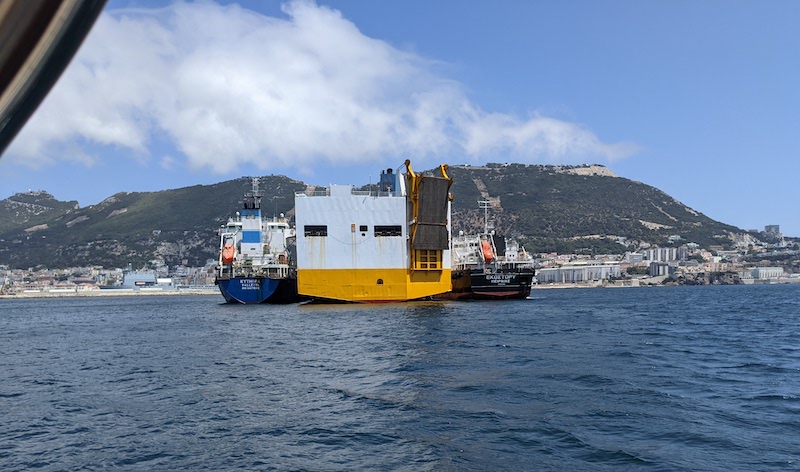
They were anchored so close together that as we nosed around the stern of these rafted ships, another supply tanker might just be barreling down in front of us, or overtaking us from the stern. It was all hands and eyes on deck. Adding to the message of commercial-boats-welcome-others-not-so-much, we headed to an anchorage off the beach at La Linea, joining a few other boats at a spot rumored to be illegal for small boat anchoring. Boaters here were prone to being swatted away by the maritime police despite it being marked as an anchorage on the chart. Gibraltar is known as a good re-supply area. Fuel is duty free here, which might explain the preponderance of bunkering operations in the harbor. But for us, we just needed to find a grocery store.
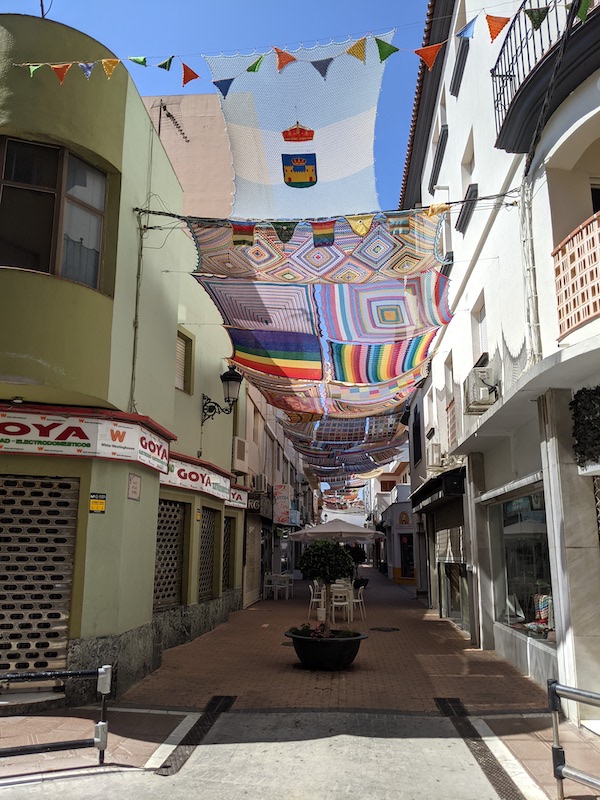
La Linea is technically part of Spain, and although we got lost on our walk to find a grocery store, we didn’t cross the line just five minutes south into the territory of Gibraltar. So close, yet so far!
With our stores replenished, we were left to debate the merits of staying on anchor at La Linea, with the threat of being asked to move in the middle of the night, or seeking out an anchorage across the expansive harbor. We chose the later, only to find out the anchorage we were headed toward also forbid anchoring, apparently because it was in a marine reserve area. With the amount of hydrocarbons being emitted by all of the big boats in this harbor burning putrid bunker fuel, the dirtiest fuel imaginable, it seemed like Gibraltar needed a lot more of these marine reserves. We were down to one bullet in the magazine, and that was the small harbor of Tarifa at the western end of Gibraltar Strait, requiring us to transit the Strait today … now, as dusk approached. The winds were uncharacteristically out of the east, making our westbound transit a bit more practical despite a strong eastbound current. Karen and I looked at each other and decided, with a combination of equal amounts bravado and angst, to go for it and run the Strait, even though we had already come 50 miles. Tarifa is a name you hear all of the time on the radio in these waters — ‘Tarifa Traffic’ is the radio handle that acts like the air traffic controller of vessel traffic through the Strait. The town also has a reputation for extremely high winds, with 40 knot blows not uncommon and a wind of at least 30 knots per day for 300 days out of the year. Hoping this would be one of the other 65 days, we raised our jib and motor sailed westbound close to the northern shore to get some relief from the counter current. As Tarifa started to come into view, we killed the engine and enjoyed 7 knots of boat speed with just the jib up. And just as quick, it wasn’t fun anymore. The wind speed hit 20 knots and we started to make a plan to furl the jib. Suddenly, I saw the anemometer shoot up to 38 knots. There it was, the 300 days per year statistic continuing to make its mark. I started cranking in on the winch to furl the jib and immediately the line became taut. Something was jammed. When you have high winds and can’t get the sail furled, it’s extremely dangerous. Rigging can break, sails can rip to shreds. Karen was trying to keep some tension on the jib sheet but the whipping of the jib was pulling the sheets out of her hands and slapping them mercilessly on the deck, with the jib itself snapping and cracking in the blow. We tried turning upwind slightly, but the furling line was still tight as a guitar string and we were headed directly for rocks on the north shore. I cranked the winch even harder, not sure what else to do, but fearing my actions might cause blocks, lines or furlers to explode into pieces under the load. Finally, I gave up and ran along the side deck to the bow, where the problem was clearly evident. As we started to furl the jib, slack sail material had caught the rolled up Code 0 halyard in its path, and tried to roll that line inside the jib. My cranking effort was about to do real damage. Back at the cockpit, we headed on a beam to the wind and let the jib out further, despite it cracking even louder in the wind, until it was free of its death grip on the Code 0 halyard. Sheets were snapping like a hundred school kids cracking their towels at once in a junior high school locker room. With the jib blowing away from the halyard, it furled up slowly and steadily, until the cacophony died down and we had the sails and lines all restrained and put in their place. We were both exhausted. The rocky northern shore kept looming closer and we breathed a sign of relief as we redirected Sea Rose under motor back westbound out the Strait.
In the fading light and reduced heart rate, Karen guided us into the anchorage at Tarifa, where a few kite boarders were just wrapping up their day of play in the high winds. We crept into the beach slowly to find a good anchoring depth, dropped the hook, backed down to make sure it was set, and then shut down the engine. The day’s navigating was now over, thank goodness.
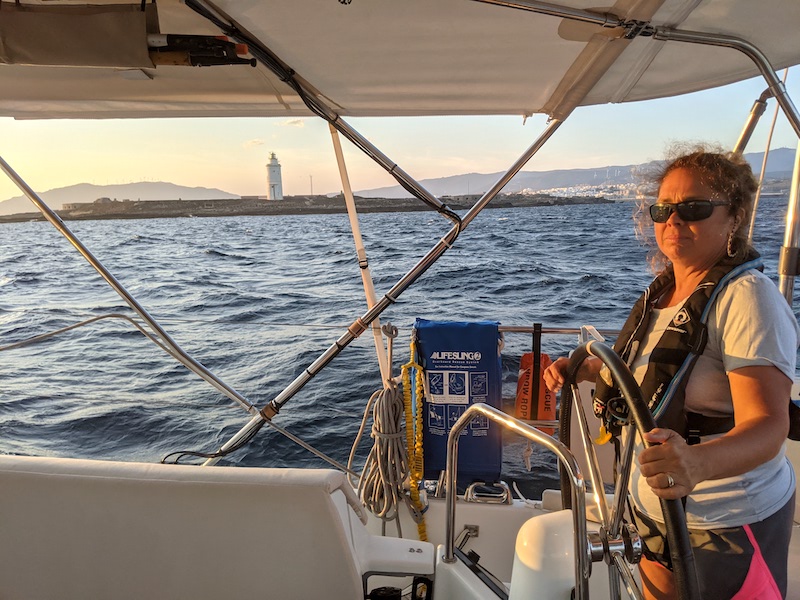

Tarifa is the southern most point of the European continent, and was the landing spot of the Moors as they took over the Iberian peninsula. All we needed to take was a quick dinner and flat bed. But we had been told by another boater about an excellent seminar on the orcas, recorded a few months ago by one of the lead scientists in the Atlantic Orca Working Group. It felt prudent to watch it before our run tomorrow through these orca-infested waters. There were a lot of theories about why the orcas started attacking sailboats, but the scientist Ruth Esteban, was hesitant without additional data to validate these theories. One that was most intriguing to me related to Covid 19 in a circuitous way. With fewer fishing boats and tuna nets in use since Covid, the orcas can’t hunt tuna in the same they used to. So they go after boats. Regardless, the working group’s suggestion if one were to have an ‘encounter’ was to furl sails, stop the engine, step away from the helm, and secure anything in the cabin that might come loose in a sudden movement of the boat. It was interesting to hear a scientist’s perspective, but in the end the video likely made us even more anxious.
In the morning, we posted a cheat sheet in the cockpit of what we would do if orcas approached us. I also mounted several cameras with various angles so that we could capture video to send to the working group. Karen constructed a detailed route in the chart plotter along the coast from Tarifa to Cadiz, keeping us in no more than 10-15m of water, while avoiding off-lying rocks and other hazards. And we discussed how we would handle watches. Without question, we would both be 100% dedicated to navigating until we were safely tied up in Cadiz. One person would be at the helm, the other up on the foredeck sweeping for shallows, other boats, and dorsal fins. This would allow the person at the helm to look down at the chartplotter as needed without worrying about hitting something. We agreed to wear our lifejackets all day and to switch positions every hour.
At the start, as we pulled up anchor at Tarifa with just enough morning light to see, it was somewhat anticlimactic. There was no wind, the water was flat, and the scenery tremendous. We never navigate this close to shore, but the upside is that we could enjoy the cliffs and rocks and beaches with clarity, as long shadows were cast upon the waterfront. When I took over at the helm, I found myself steering away from the coast and out to sea. I had to fight the subconscious thought that we were too close and could run aground.
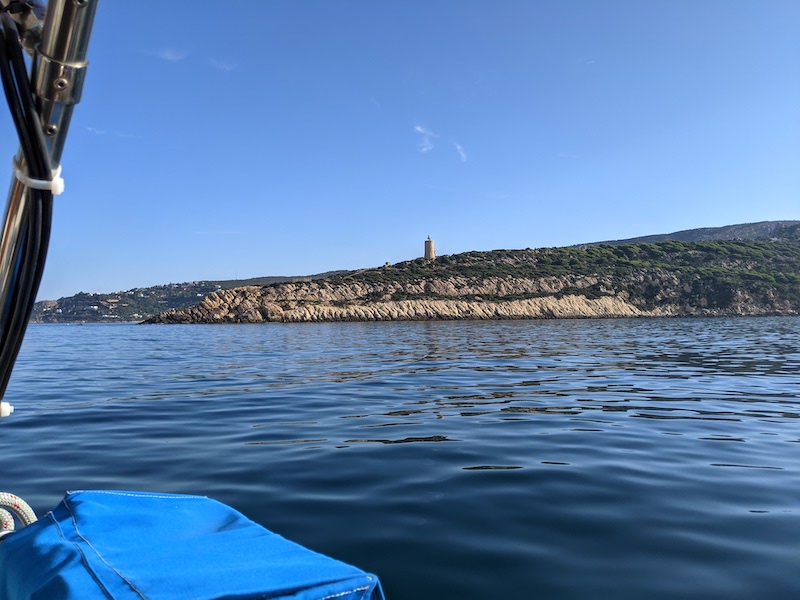
Back on the foredeck, I found my mind drifting off at times. As much as you try, it is hard to singularly focus on a task for an hour at a time. Watching for passing cars at a crosswalk is one thing, but staring for an hour for an errant driver is another challenge all together. Still, we stuck to our plan, while taking in the beautiful views of the coastline. Then a call came in on the VHF. A boater was trying to reach Tarifa Traffic. We huddled around the handset to hear them explain how they had been attacked earlier this morning by orcas. We tried to get a lat/lon on their position, but were unsuccessful. Hearing a firsthand account of an attack made us all the more concerned. The only bright side was the fact their call was a bit scratchy, indicating that they were some distance away from us. But the attack had occurred earlier in the morning, and their location at that time was unclear.
We approached the town of Barbate. The waters off of here had been a common area for attacks over the last few weeks, and boats that were disabled had been towed into the local boatyard. I could see in the distance the signature bright orange color of a search and rescue boat exiting the Barbate harbor entrance and heading out to sea at full throttle. We had not heard any calls on the radio, but it didn’t take much imagination to guess what they were doing.
We followed the indent of the coast at Barbate tightly. Strangely, small fishing boats were scattered all over the waters here, some fishing close into shore, others motoring out to fish in deeper waters. We came up behind another sailboat leaving the Barbate harbor, but soon we turned north to follow the inshore route while they headed out into deeper waters. Had they not heard the warnings, and recommendations of other boaters? When we were in the Medicane last year, I remember having the same feeling, as we headed north a safe distance away while a few boaters headed south right into the path of the storm.
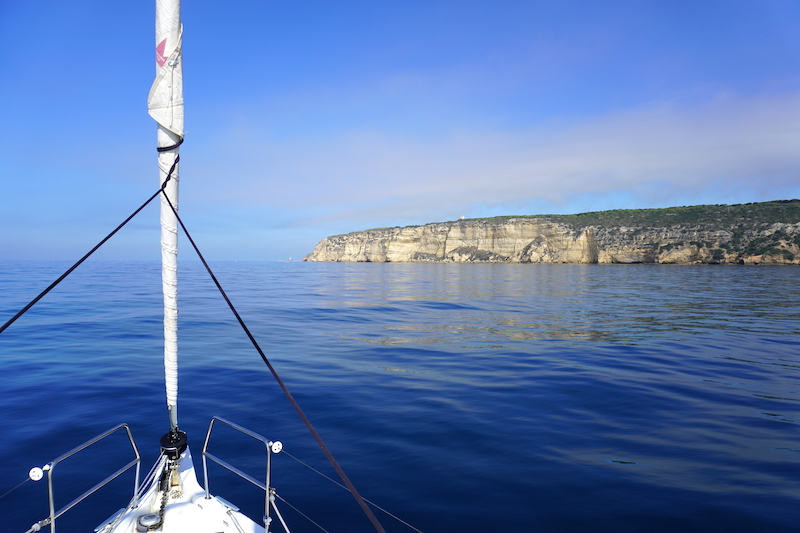
Off of Barbate is Cape Trafalgar, site of the historic Battle of Trafalgar during the Napoleonic wars. Other than some fluky currents and shallow waters, we negotiated the sharp point of land without issue, passing a large collection of small fishing boats and even a group of kayakers. Again, we were left to wonder if they had heard of the recent orca attacks. Maybe we were being too cautious, I thought. As we cleared the Cape and navigated through a long stretch of shallow reefs, we heard a distinctly British women’s voice come on the radio, asking for news on the latest orca attack locations and how best to navigate around Cape Trafalgar. She was a stranger to me, but the tension and worry in her voice were unmistakable. When no one else replied, I hailed her on the radio, but other traffic got in the way of us connecting. And then it became clear why the radio traffic was so busy. We heard a clear call on the radio. A man was calling to a catamaran nearby them. He kept repeating that ‘they are leaving me and coming to you now. Watch out!’ We were understandably eager to find out their location. Two attacks in one day, and no position data. I called into Tarifa Traffic, as did other boats, asking for a relay of the boat’s coordinates. No answer came. Finally, in a wise move on their part, Tarifa Traffic started a Securite call, a general safety call to all vessels in the listening area. They reported an orca attack just offshore of Barbate, and announced the start of a navigation exclusion zone in that area, an area we had just passed through an hour before. That could have been us if we were further off-shore and we had not left so early from Tarifa.
Later we heard that the orcas were going back and forth between two boats, causing damage to both. A search and rescue boat came to the scene and tried to scare the orcas away, but they continued to attack. One boat lost steerage and had to be towed into port.
This was all chilling news as we tried to concentrate on our inshore route. We felt very fortunate to escape being attacked, but very sad for those who had been.
Staying close inshore on the remaining 20 miles to Cadiz was complicated by numerous submerged rocks, laid out in even rows like wheel tracks on a freshly cut lawn. It continued to surprise us how many sailboats were out in deep water, as if this was any random weekend afternoon of casual, blissful sailing. More sailboats kept coming out of the Cadiz harbor channel, lost in their tactics of when and where to tack, while we weary sailors speedily cut the channel buoys short to make it inside the protected harbor without delay. Nothing could have been better than the inner sanctum of Cadiz’s Marina Puerto America, inside the inner breakwater. As we nestled into our assigned slip, this time comfortably with a finger pier next to us just like docks back home, words can not properly capture how relieved we were to have made it through the gauntlet of orcas. We weren’t out of the woods completely, as a few attacks had come in from points further up the coast, but we were through the worst of it. It was time for a walk on terra firma, a quick dinner, and a long sleep!
